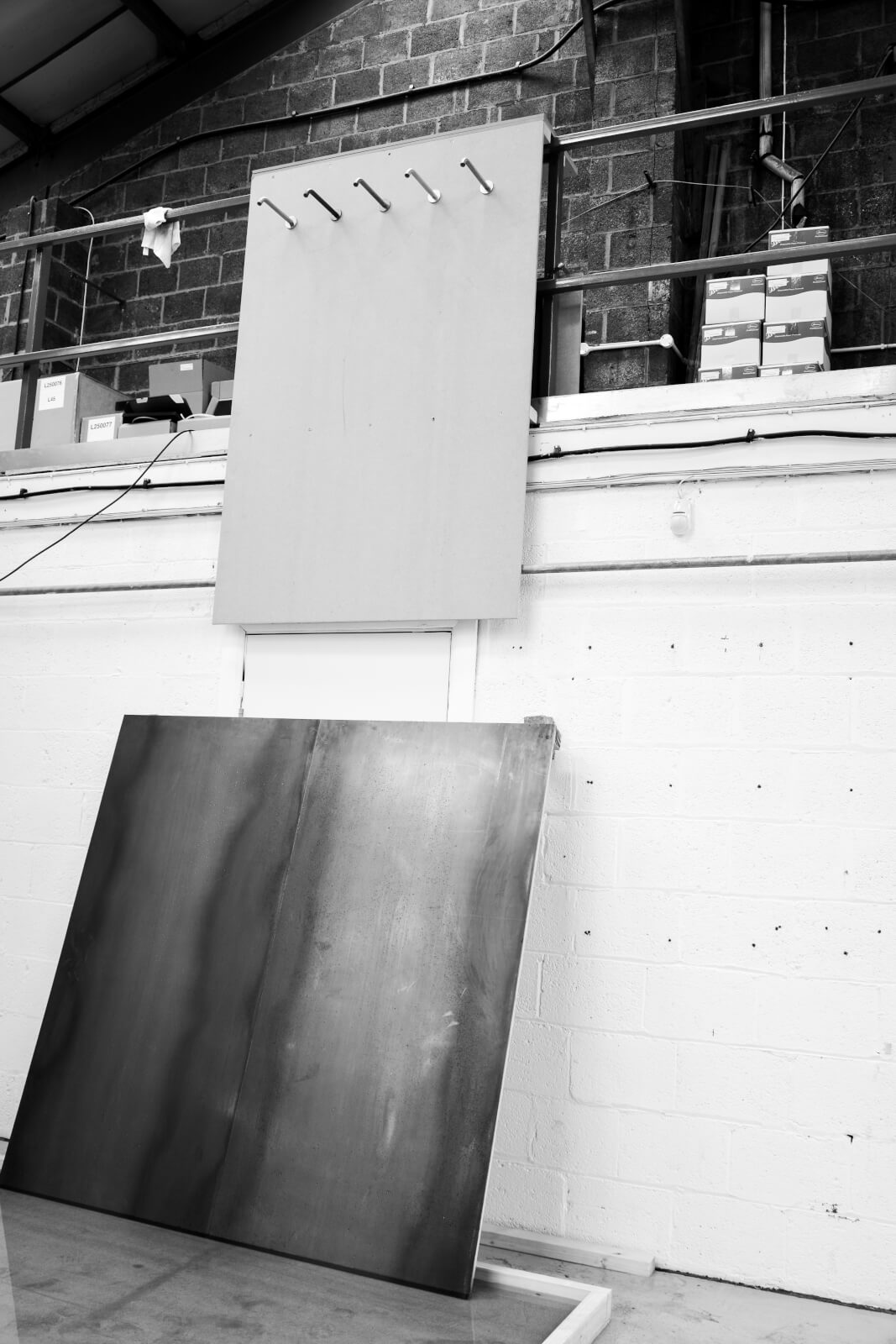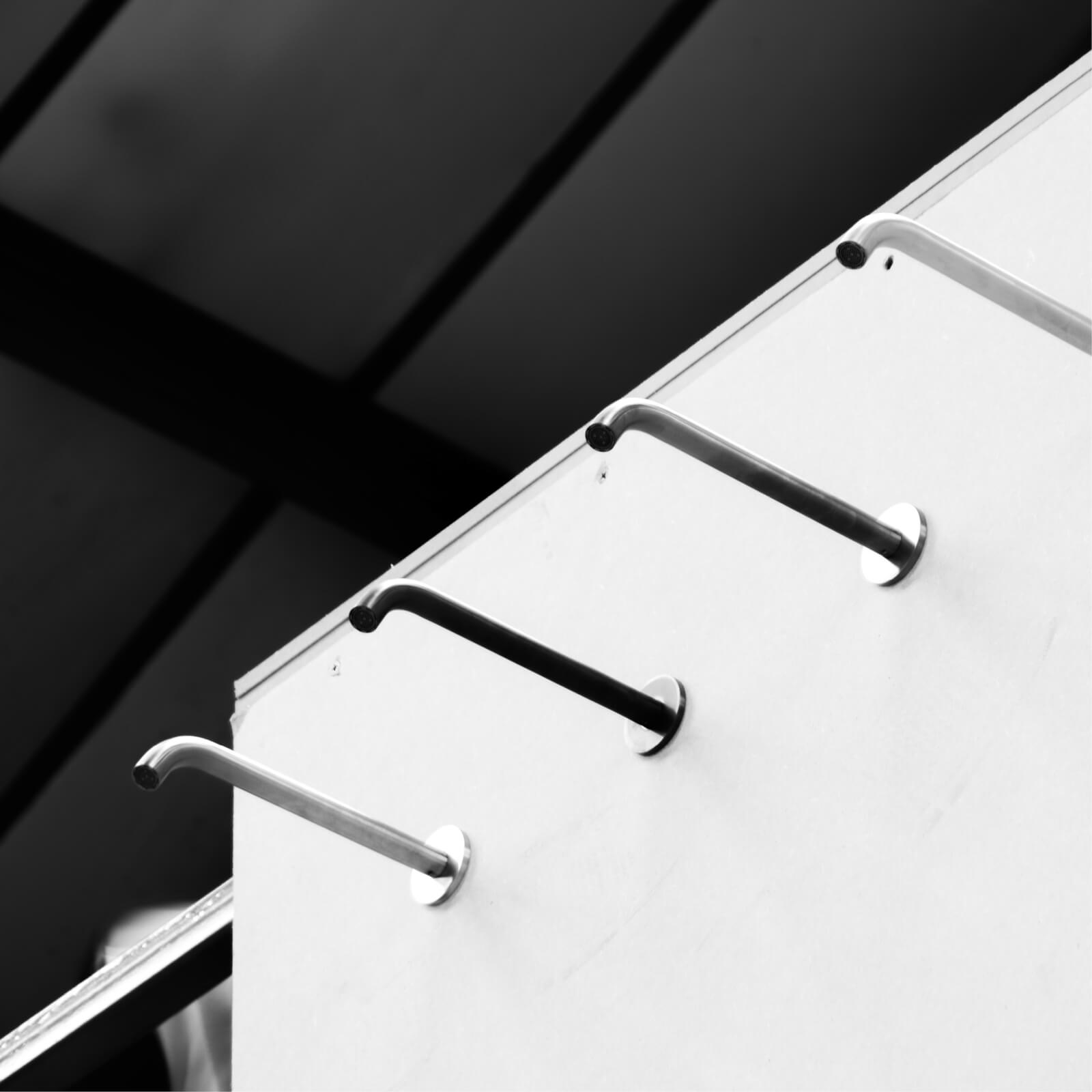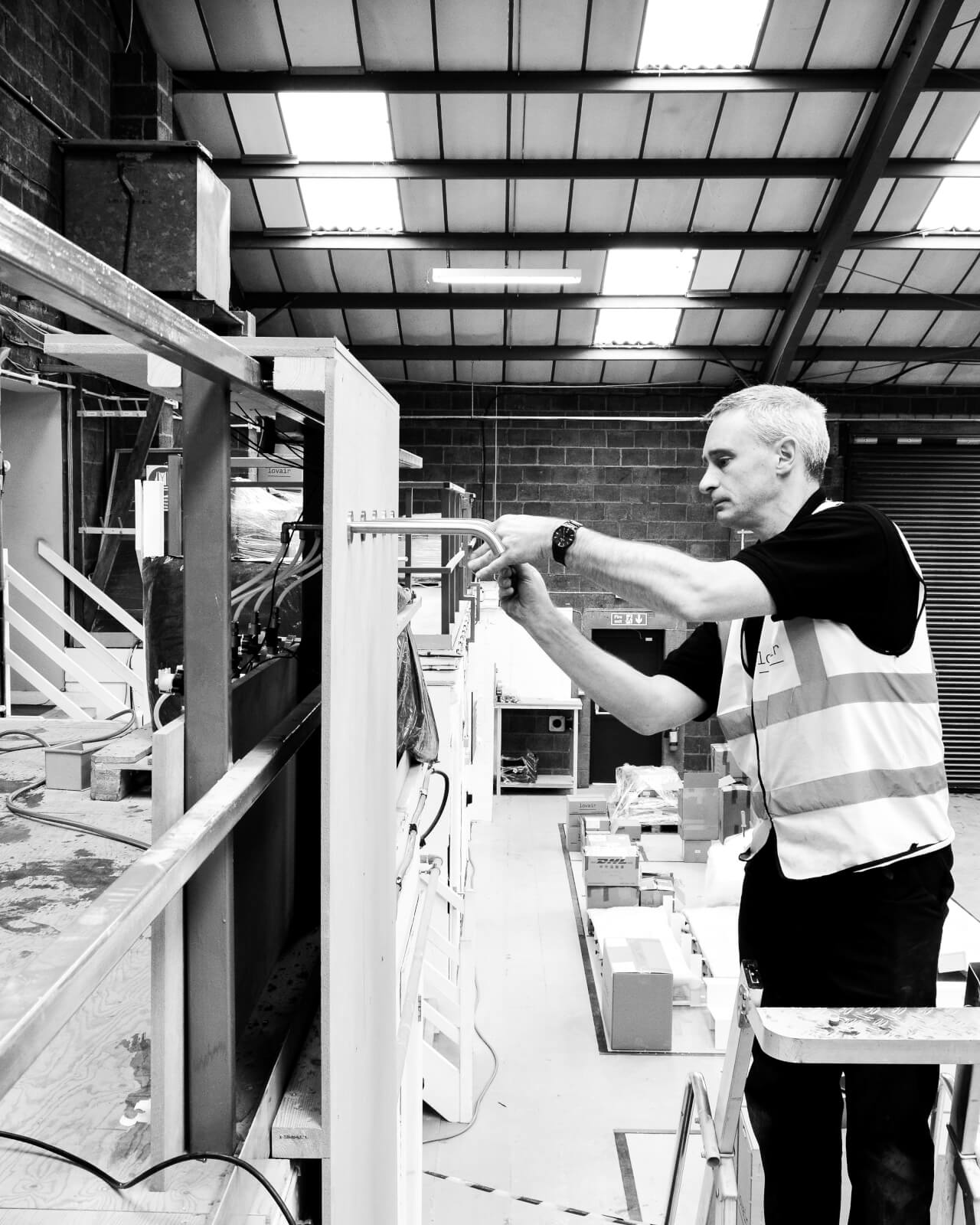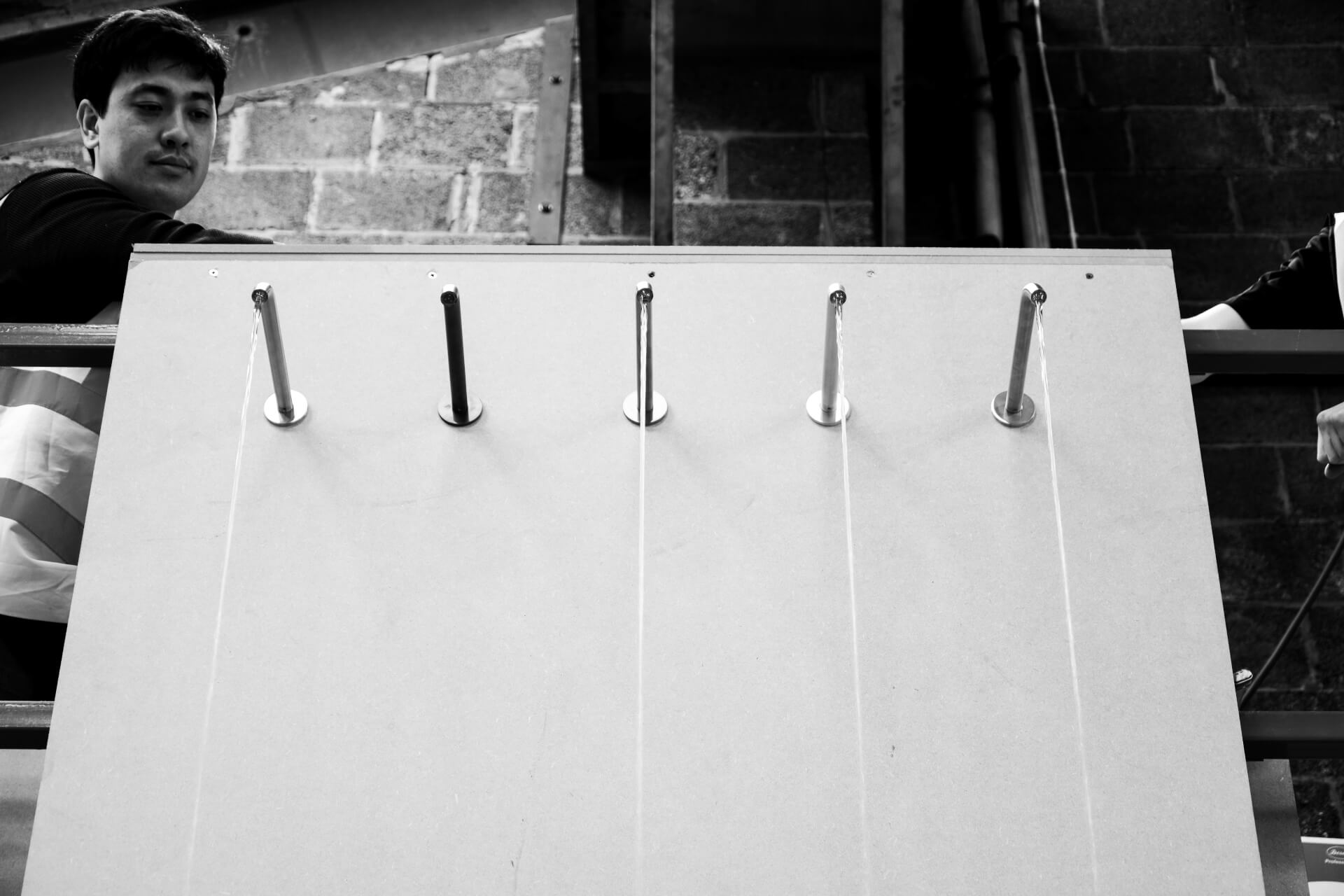At the Splash Lab, pioneering and experimentation are two of our core values. As part of the building journey for our new London showroom, when the suggestion came up for a four-metre waterfall using our TSL-881 capacitive taps, we decided to get down and dirty and build a full-size prototype at our Manchester lab to test the principles and check the correct angles for the steel parts of the proposed feature.
 From a simple experiment like this, along with many of the other process and product experiments we run across all departments from Marketing to Project Management, we find several benefits and thought it would be a good idea to record them in the hope of encouraging others to step away from their desks and start iterating and testing, whatever industry or department you are in. There is so much to be learnt by getting hands-on and building or prototyping a concept.
8 benefits of building prototypes early on in the design process
Below are eight of the unexpected learnings and challenged assumptions we encountered during the prototyping process for our waterfall project.
From a simple experiment like this, along with many of the other process and product experiments we run across all departments from Marketing to Project Management, we find several benefits and thought it would be a good idea to record them in the hope of encouraging others to step away from their desks and start iterating and testing, whatever industry or department you are in. There is so much to be learnt by getting hands-on and building or prototyping a concept.
8 benefits of building prototypes early on in the design process
Below are eight of the unexpected learnings and challenged assumptions we encountered during the prototyping process for our waterfall project.
 1. Side effects
Some of the most interesting discoveries come from the unexpected side effects of the experiment or the hidden-within results you didn’t anticipate. These are the sort of discoveries that can hugely impact the quality of the design and the relevance of the end product. This helps to reinforce the importance of having an open mind. To approach an experiment with a set idea of the outcome is not to experiment at all.
2. Removing conceptual flaws
Getting the right answer is sometimes not as important as asking the right question or asking the question in a right way. Bertrand Russell stated: “If you do not know how to ask the right question, you discover nothing.” As you start to build a concept you may have been focussing on for while, reviewing whether you are asking the right question allows you to take a step back and assess whether this is the right way to meet the goals of the project.
1. Side effects
Some of the most interesting discoveries come from the unexpected side effects of the experiment or the hidden-within results you didn’t anticipate. These are the sort of discoveries that can hugely impact the quality of the design and the relevance of the end product. This helps to reinforce the importance of having an open mind. To approach an experiment with a set idea of the outcome is not to experiment at all.
2. Removing conceptual flaws
Getting the right answer is sometimes not as important as asking the right question or asking the question in a right way. Bertrand Russell stated: “If you do not know how to ask the right question, you discover nothing.” As you start to build a concept you may have been focussing on for while, reviewing whether you are asking the right question allows you to take a step back and assess whether this is the right way to meet the goals of the project.
 3. Uncover value early on
A really interesting principle for us came from the SCRUM book by Jeff Sutherland. In it he takes the Pareto 80/20 principle and applies it to product development. "80% of the product's value is hidden in 20% of its features.” By bringing those ideas into the real world as soon as possible, testing and sharing them, it helps us uncover that value earlier on, saving time and budget on un-necessary features.
4. Building a safe environment
When you create an encouraging space, it allows you to make mistakes with no consequences. This safe environment helps us embed one of our key tenets, which is there is no such thing as failure. As long as you learn from experience, mistakes can help uncover new findings or paradigms on a situation that can be really helpful later on. As Thomas Edison said when trying to develop the incandescent lightbulb, "I have not failed. I've just found 10,000 ways that won't work."
5. Step away from your desk
Physical stagnation leads to mental stagnation. A change of circumstance or environment has been proven to stimulate fresh thoughts several times. Just the physical act of stepping away from your desk and actively moving can help boost creative solutions around the project. We’ve all been in the situation where you get to a point where all you can think of is one channel for a solution to a problem and being able to look at the problem from a different point of view, even physically, can help assist breakthroughs.
3. Uncover value early on
A really interesting principle for us came from the SCRUM book by Jeff Sutherland. In it he takes the Pareto 80/20 principle and applies it to product development. "80% of the product's value is hidden in 20% of its features.” By bringing those ideas into the real world as soon as possible, testing and sharing them, it helps us uncover that value earlier on, saving time and budget on un-necessary features.
4. Building a safe environment
When you create an encouraging space, it allows you to make mistakes with no consequences. This safe environment helps us embed one of our key tenets, which is there is no such thing as failure. As long as you learn from experience, mistakes can help uncover new findings or paradigms on a situation that can be really helpful later on. As Thomas Edison said when trying to develop the incandescent lightbulb, "I have not failed. I've just found 10,000 ways that won't work."
5. Step away from your desk
Physical stagnation leads to mental stagnation. A change of circumstance or environment has been proven to stimulate fresh thoughts several times. Just the physical act of stepping away from your desk and actively moving can help boost creative solutions around the project. We’ve all been in the situation where you get to a point where all you can think of is one channel for a solution to a problem and being able to look at the problem from a different point of view, even physically, can help assist breakthroughs.
 6. CAD sim vs reality
We heavily use – and find a lot of value in – running virtual simulation tests, whether that be water flow, structural loading or user flow. However, real-life installations often present a less-than-perfect scenario, which allows the design to be tested to a level in which it may be forced to in the field. In this case, it could be insufficient water pressure or grit in the pipes. A physical build allows you to overcome real-world problems, which may not occur in a controlled environment.
7. Learning to improvise
When you are building something for the first time, like our four-metre waterfall, things don’t always go to plan or work as expected, which then requires improvisation in terms or materials or processes. In this case, our challenge was to get mains water four metres in the air with enough pressure to be able to allow the taps to function at the correct flow rate. After suggestions and trials of pond pumps, shower pumps and gravity-fed water tanks to no avail, a trusty hosepipe from our warehouse toilets did the trick.
8. Teamwork spirit
Another great thing about building a full-size experiment like our fountain is that you get to really work together across departments and learn from each other and share ideas while solving problems. Working with people outside of your skill set and getting hands-on allows a variety of expertise to come to the fore to find unexpected solutions.
There is much to be gained from a 'learning by doing' approach. When turning a concept into a real-world manifestation, you embark on an adventure where you don't know how the final product will turn out, but we found that if you adopt a mindset of finding value in mistakes and positively embrace improvisations and re-evaluations, you reap the rewards of unexpected benefits and conclusions – all valuable lessons in the prototyping journey.
6. CAD sim vs reality
We heavily use – and find a lot of value in – running virtual simulation tests, whether that be water flow, structural loading or user flow. However, real-life installations often present a less-than-perfect scenario, which allows the design to be tested to a level in which it may be forced to in the field. In this case, it could be insufficient water pressure or grit in the pipes. A physical build allows you to overcome real-world problems, which may not occur in a controlled environment.
7. Learning to improvise
When you are building something for the first time, like our four-metre waterfall, things don’t always go to plan or work as expected, which then requires improvisation in terms or materials or processes. In this case, our challenge was to get mains water four metres in the air with enough pressure to be able to allow the taps to function at the correct flow rate. After suggestions and trials of pond pumps, shower pumps and gravity-fed water tanks to no avail, a trusty hosepipe from our warehouse toilets did the trick.
8. Teamwork spirit
Another great thing about building a full-size experiment like our fountain is that you get to really work together across departments and learn from each other and share ideas while solving problems. Working with people outside of your skill set and getting hands-on allows a variety of expertise to come to the fore to find unexpected solutions.
There is much to be gained from a 'learning by doing' approach. When turning a concept into a real-world manifestation, you embark on an adventure where you don't know how the final product will turn out, but we found that if you adopt a mindset of finding value in mistakes and positively embrace improvisations and re-evaluations, you reap the rewards of unexpected benefits and conclusions – all valuable lessons in the prototyping journey.
 From a simple experiment like this, along with many of the other process and product experiments we run across all departments from Marketing to Project Management, we find several benefits and thought it would be a good idea to record them in the hope of encouraging others to step away from their desks and start iterating and testing, whatever industry or department you are in. There is so much to be learnt by getting hands-on and building or prototyping a concept.
8 benefits of building prototypes early on in the design process
Below are eight of the unexpected learnings and challenged assumptions we encountered during the prototyping process for our waterfall project.
From a simple experiment like this, along with many of the other process and product experiments we run across all departments from Marketing to Project Management, we find several benefits and thought it would be a good idea to record them in the hope of encouraging others to step away from their desks and start iterating and testing, whatever industry or department you are in. There is so much to be learnt by getting hands-on and building or prototyping a concept.
8 benefits of building prototypes early on in the design process
Below are eight of the unexpected learnings and challenged assumptions we encountered during the prototyping process for our waterfall project.
 1. Side effects
Some of the most interesting discoveries come from the unexpected side effects of the experiment or the hidden-within results you didn’t anticipate. These are the sort of discoveries that can hugely impact the quality of the design and the relevance of the end product. This helps to reinforce the importance of having an open mind. To approach an experiment with a set idea of the outcome is not to experiment at all.
2. Removing conceptual flaws
Getting the right answer is sometimes not as important as asking the right question or asking the question in a right way. Bertrand Russell stated: “If you do not know how to ask the right question, you discover nothing.” As you start to build a concept you may have been focussing on for while, reviewing whether you are asking the right question allows you to take a step back and assess whether this is the right way to meet the goals of the project.
1. Side effects
Some of the most interesting discoveries come from the unexpected side effects of the experiment or the hidden-within results you didn’t anticipate. These are the sort of discoveries that can hugely impact the quality of the design and the relevance of the end product. This helps to reinforce the importance of having an open mind. To approach an experiment with a set idea of the outcome is not to experiment at all.
2. Removing conceptual flaws
Getting the right answer is sometimes not as important as asking the right question or asking the question in a right way. Bertrand Russell stated: “If you do not know how to ask the right question, you discover nothing.” As you start to build a concept you may have been focussing on for while, reviewing whether you are asking the right question allows you to take a step back and assess whether this is the right way to meet the goals of the project.
 3. Uncover value early on
A really interesting principle for us came from the SCRUM book by Jeff Sutherland. In it he takes the Pareto 80/20 principle and applies it to product development. "80% of the product's value is hidden in 20% of its features.” By bringing those ideas into the real world as soon as possible, testing and sharing them, it helps us uncover that value earlier on, saving time and budget on un-necessary features.
4. Building a safe environment
When you create an encouraging space, it allows you to make mistakes with no consequences. This safe environment helps us embed one of our key tenets, which is there is no such thing as failure. As long as you learn from experience, mistakes can help uncover new findings or paradigms on a situation that can be really helpful later on. As Thomas Edison said when trying to develop the incandescent lightbulb, "I have not failed. I've just found 10,000 ways that won't work."
5. Step away from your desk
Physical stagnation leads to mental stagnation. A change of circumstance or environment has been proven to stimulate fresh thoughts several times. Just the physical act of stepping away from your desk and actively moving can help boost creative solutions around the project. We’ve all been in the situation where you get to a point where all you can think of is one channel for a solution to a problem and being able to look at the problem from a different point of view, even physically, can help assist breakthroughs.
3. Uncover value early on
A really interesting principle for us came from the SCRUM book by Jeff Sutherland. In it he takes the Pareto 80/20 principle and applies it to product development. "80% of the product's value is hidden in 20% of its features.” By bringing those ideas into the real world as soon as possible, testing and sharing them, it helps us uncover that value earlier on, saving time and budget on un-necessary features.
4. Building a safe environment
When you create an encouraging space, it allows you to make mistakes with no consequences. This safe environment helps us embed one of our key tenets, which is there is no such thing as failure. As long as you learn from experience, mistakes can help uncover new findings or paradigms on a situation that can be really helpful later on. As Thomas Edison said when trying to develop the incandescent lightbulb, "I have not failed. I've just found 10,000 ways that won't work."
5. Step away from your desk
Physical stagnation leads to mental stagnation. A change of circumstance or environment has been proven to stimulate fresh thoughts several times. Just the physical act of stepping away from your desk and actively moving can help boost creative solutions around the project. We’ve all been in the situation where you get to a point where all you can think of is one channel for a solution to a problem and being able to look at the problem from a different point of view, even physically, can help assist breakthroughs.
 6. CAD sim vs reality
We heavily use – and find a lot of value in – running virtual simulation tests, whether that be water flow, structural loading or user flow. However, real-life installations often present a less-than-perfect scenario, which allows the design to be tested to a level in which it may be forced to in the field. In this case, it could be insufficient water pressure or grit in the pipes. A physical build allows you to overcome real-world problems, which may not occur in a controlled environment.
7. Learning to improvise
When you are building something for the first time, like our four-metre waterfall, things don’t always go to plan or work as expected, which then requires improvisation in terms or materials or processes. In this case, our challenge was to get mains water four metres in the air with enough pressure to be able to allow the taps to function at the correct flow rate. After suggestions and trials of pond pumps, shower pumps and gravity-fed water tanks to no avail, a trusty hosepipe from our warehouse toilets did the trick.
8. Teamwork spirit
Another great thing about building a full-size experiment like our fountain is that you get to really work together across departments and learn from each other and share ideas while solving problems. Working with people outside of your skill set and getting hands-on allows a variety of expertise to come to the fore to find unexpected solutions.
There is much to be gained from a 'learning by doing' approach. When turning a concept into a real-world manifestation, you embark on an adventure where you don't know how the final product will turn out, but we found that if you adopt a mindset of finding value in mistakes and positively embrace improvisations and re-evaluations, you reap the rewards of unexpected benefits and conclusions – all valuable lessons in the prototyping journey.
6. CAD sim vs reality
We heavily use – and find a lot of value in – running virtual simulation tests, whether that be water flow, structural loading or user flow. However, real-life installations often present a less-than-perfect scenario, which allows the design to be tested to a level in which it may be forced to in the field. In this case, it could be insufficient water pressure or grit in the pipes. A physical build allows you to overcome real-world problems, which may not occur in a controlled environment.
7. Learning to improvise
When you are building something for the first time, like our four-metre waterfall, things don’t always go to plan or work as expected, which then requires improvisation in terms or materials or processes. In this case, our challenge was to get mains water four metres in the air with enough pressure to be able to allow the taps to function at the correct flow rate. After suggestions and trials of pond pumps, shower pumps and gravity-fed water tanks to no avail, a trusty hosepipe from our warehouse toilets did the trick.
8. Teamwork spirit
Another great thing about building a full-size experiment like our fountain is that you get to really work together across departments and learn from each other and share ideas while solving problems. Working with people outside of your skill set and getting hands-on allows a variety of expertise to come to the fore to find unexpected solutions.
There is much to be gained from a 'learning by doing' approach. When turning a concept into a real-world manifestation, you embark on an adventure where you don't know how the final product will turn out, but we found that if you adopt a mindset of finding value in mistakes and positively embrace improvisations and re-evaluations, you reap the rewards of unexpected benefits and conclusions – all valuable lessons in the prototyping journey.